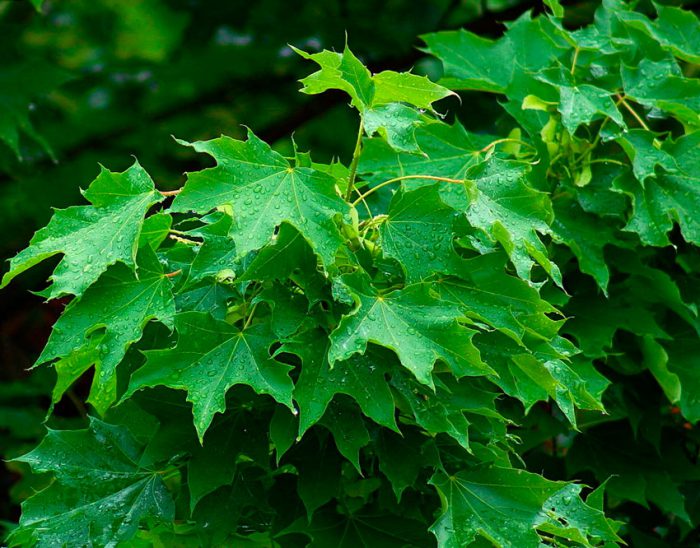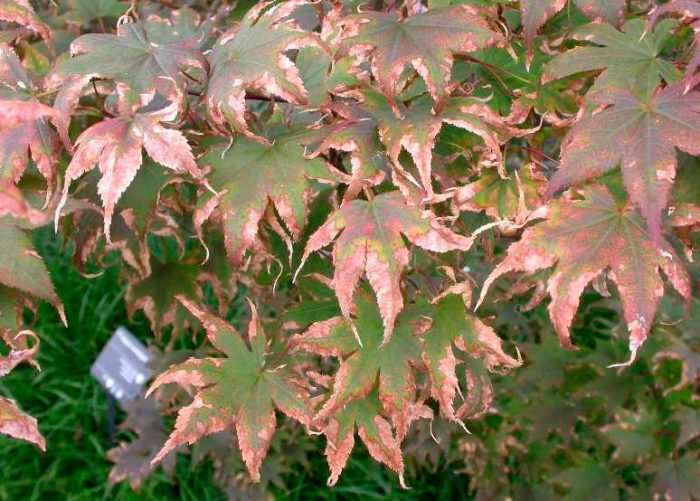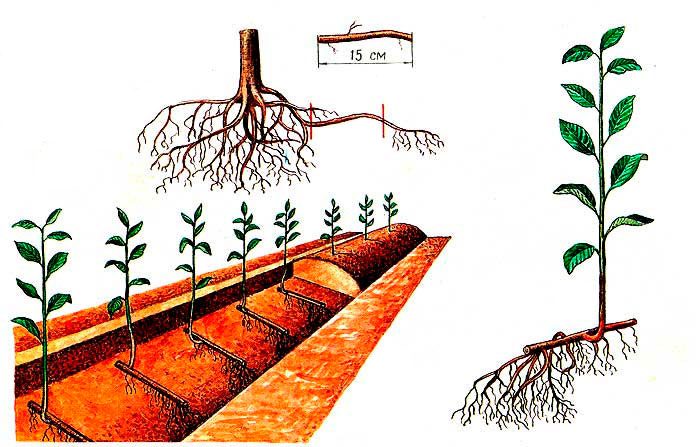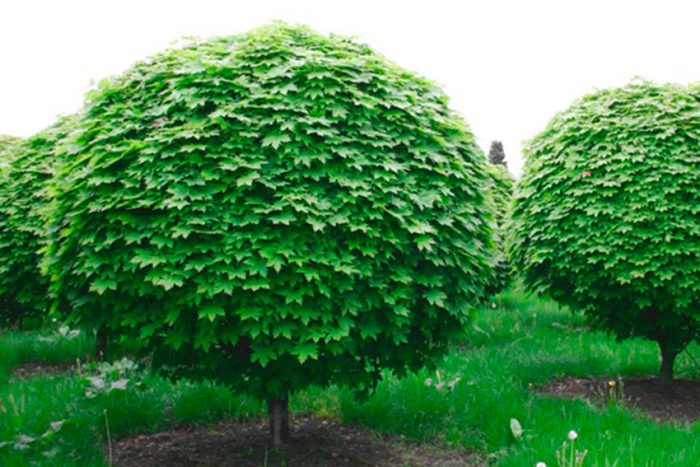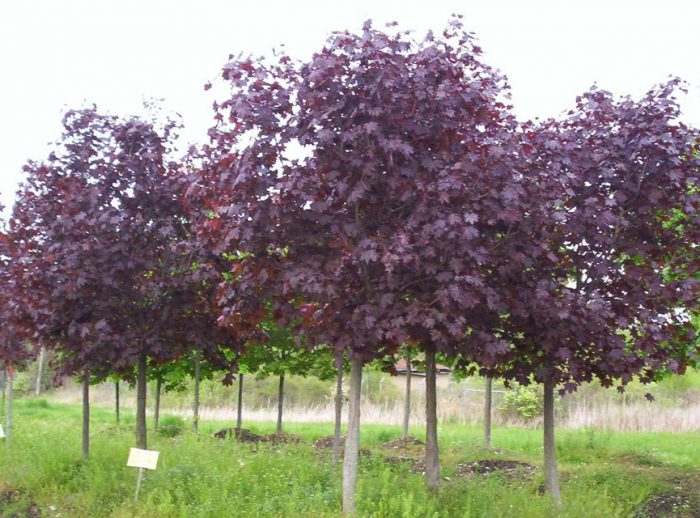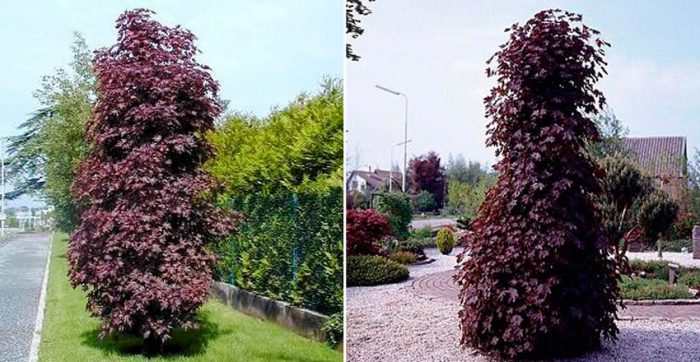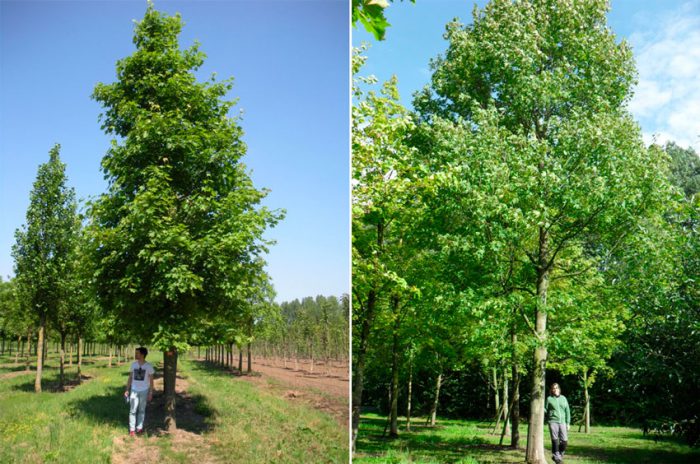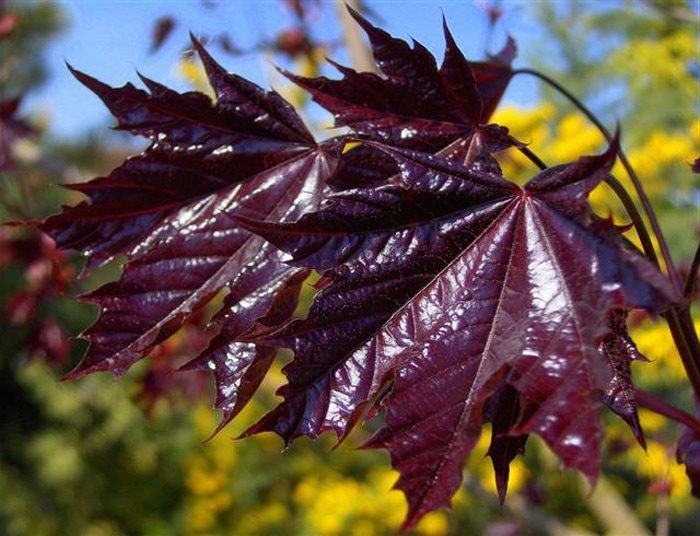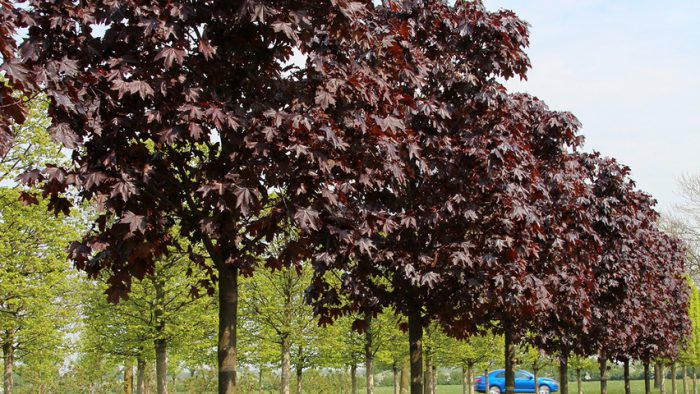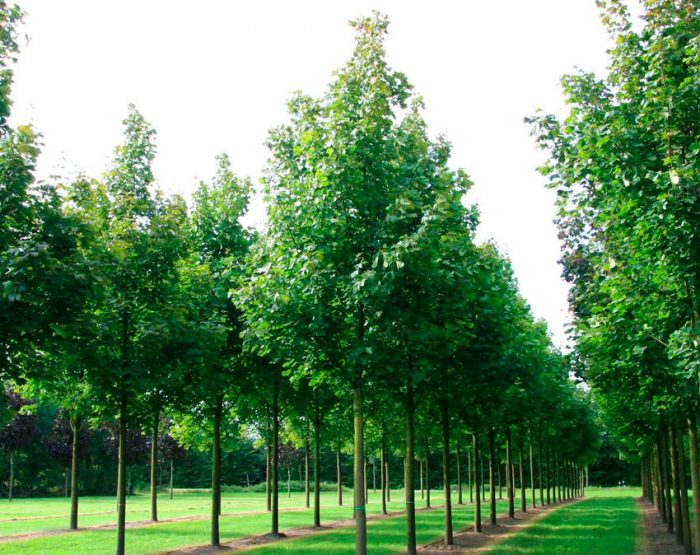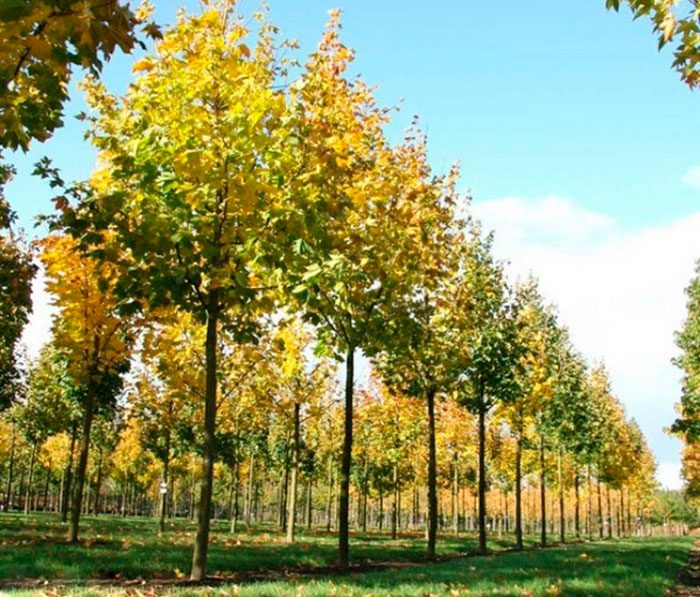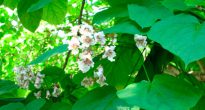A tree such as the Norway maple (Acer platanoides), or the sycamore maple, or the sycamore maple, is a type of maple that is often found in Europe and Western Asia. The southern border of the range of this plant reaches northern Iran, while the northern one ends at the southern regions of Scandinavia, Finland and Karelia. Such a tree prefers to grow singly or in small groups in deciduous and mixed forests.
Content
Features of Norway maple
Norway maple has a height of about 30 meters, sometimes it can be higher. The surface of the trunk is covered with fissured bark of a gray-brownish, almost black color. The bark on young branches is gray-red and relatively smooth. The shape of the crown is round. The branches are powerful, wide, they are directed downward. Simple palm-shaped leaf plates are oppositely located, coarse-toothed blades (sometimes from 5 to 7 pieces) have a pointed end at the ends. The front of the foliage is dark green and the back is light green. In autumn, the leaf plates acquire an orange or yellow color. If you break the petioles or veins at the leaves, then a milk-colored juice will appear at the site of damage. Flowering is observed in the first half of May. The scutellum inflorescences consist of 15-30 fragrant flowers, colored greenish-yellow. Such a tree belongs to dioecious plants, so there can be either male or female flowers on it. Pollination is due to insects. The nectary has the form of a flat ring, the bases of the stamens are immersed in it. It is placed between the petals and the ovary. The fruit is a lionfish that splits into 2 one-seeded fruitlets. Fruit ripening occurs in the last days of summer, while they can remain on the branches until the end of the winter period. Norway maple is a good honey plant.
Such a tree is outwardly similar to another species, namely, sugar maple or Canadian maple. These plants can be easily distinguished by the color of the sap that stands out from the petioles, for example, in the sugar maple, it is transparent. Also, the Norway maple does not have such a rough and rough bark as the sugar maple, and in autumn its leaf plates acquire a less bright color.In the Norway maple, the shape of the leaf plates is more flattering. The buds of the Norway maple are light red, while the buds of the sugar maple are deep green.
Planting the Norway maple
It is recommended to plant the Norway maple in open ground at the very beginning of the spring period or in the fall. When choosing a place for planting, you should take into account that the distance from the seedling to any other plant should be at least 2.5-3 meters. If maples are used to create a hedge, then a distance of 2 meters should be maintained between them. For planting, choose a well-lit area or one that is in light partial shade. The soil must be well-drained. When digging a hole, it should be noted that its depth should be identical to the height of the root ball. In this case, the width of the fossa must be made 4 times larger than the root ball. In the event that the groundwater on the site is too close to the soil surface, then the depth of the pit should be increased, since at its bottom it will be necessary to make a drainage layer, the thickness of which should be at least 15 centimeters. To create this layer, you can use crushed stone, broken brick or screenings.
Under no circumstances should the root system of the seedling dry out before planting. Therefore, it is recommended to immerse it in a container of water for several hours.
To fill the planting pit, a nutrient mixture consisting of humus (peat compost), sand and turf soil (3: 1: 2) should be used. First, 120 to 150 grams of Nitroammofoska must be poured into the pit, only then the root ball of the seedling is placed in it. When the roots are neatly spread out, the hole needs to be filled with a nutrient mixture. After planting, the root neck of the plant should rise several centimeters above the surface of the site. The planted maple tree must be watered using 30 liters of water. After the liquid is completely absorbed, the root collar of the seedling should fall to the level of the surface of the site. Do not forget, in the first days after planting, mulch the tree trunk circle, using dry soil or peat for this, the layer thickness should be within 3-5 centimeters.
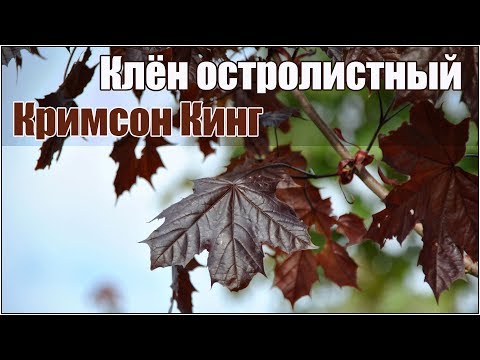

Watch this video on YouTube
Norway Maple Care
Newly planted Norway maple needs frequent watering. Even after the plant is strong and mature, it will need systematic watering, especially during the summer months. In spring and autumn, the tree is watered once every 4 weeks, and in the summer, this procedure is carried out 1 time in 7 days. When watering, a young plant should take 40 liters of water, but if the tree is adult, then 20 liters will be enough for it. But it should be borne in mind that if the color of the foliage of the tree has become pale green, then this indicates that the soil is very waterlogged. If the plant feels a lack of water, then its leaf plates droop. After watering, it is necessary to systematically loosen the surface of the trunk circle, at the same time pulling out weeds.
In the event that all the necessary fertilizers were added to the planting pit, then there is no need to feed the plants until the end of the current season. After spring comes, the maple will need to be fed; for this, the surface of the tree trunk should be covered with a three-centimeter layer of rotted manure. You can also use special slow-release nutrient tablets for feeding. They should be spread out in the root zone. From the beginning of the growing season until the end of spring, such feeding should be done once every 2 weeks, in the summer it is carried out once every 4 weeks; in the fall, there is no need to feed maple.
The dormant period for the tree begins with the first frost and lasts until March. If the maple is still young, then it will need good shelter for the winter.His bole needs to be wrapped in burlap, which is fixed with a rope. This will protect the plant from both severe frosts and rodents. The root neck of the plant must be covered with spruce branches. As the plant grows older, frost resistance increases, and soon it will not be necessary to cover it for the winter.
Pruning
Maple needs only sanitary pruning, during which all frozen, injured, dried out branches and stems should be cut off. You also need to cut out all the root growth. If desired, you can shorten those stems that stick out in different directions, and also remove the shoots growing inside the crown. Formative pruning is not necessary, since the natural spherical shape of maple is very attractive even without it.
Diseases and pests
If the branches of the tree began to die off, and small spots of a burgundy color appeared on the surface of the bark, then this indicates its infection with coral spot. Those branches that are affected must be cut and destroyed, and the cuts must be smeared with garden varnish. Garden tools should be disinfected both before and after pruning.
Of the pests, whiteflies, mealybugs and leaf weevils can settle on maple. The branches affected by whitefly larvae must be cut and destroyed, and then the plant is treated with Ammophos. For prophylactic purposes, from mealybugs, maple is processed on the leaf with Nitrafen until the buds swell. To get rid of weevils, you need to process the tree on a leaf with a solution of Chlorophos, which is prepared strictly according to the instructions.
Propagation of Norway maple
Seed reproduction
Norway maple is easy enough to propagate by seed. They are sown in the autumn in the seedling beds, during the winter they will undergo natural stratification. In spring, seedlings will appear, they will only have to be planted. You can sow seeds if you want in March, but before that they will need to be stratified. To do this, the seeds should be poured into a container filled with moistened sand, which is removed for 5-7 days in the refrigerator on a vegetable shelf.
How to propagate with air layers
Select the branch from which you will air lay. Take a sterilized knife and make several cuts on the surface of the bark, which should be obliquely. Then it is necessary to process the incisions with a means that stimulates the formation of roots (Kornevin or Heteroauxin). To prevent the edges of the cuts from joining, grains of foam must be placed in them. Then the incisions are covered with moistened moss, this part of the branch must be wrapped in a plastic bag, which is tightly fixed just above and below the wounds. Then you need to close the bag with aluminum foil or a canvas cloth so that the sun's rays do not fall on it.
Over time, young roots will appear at the cuts, they will grow into moist moss. With the onset of next spring, when the growing season begins, it will be necessary to separate the layers from the tree, while carefully removing the fabric or foil and removing the bag. It is not necessary to remove the moss; the cuttings are planted in open soil with it.
Propagation by root layers
On the overgrown root shoot, it will be necessary to make several cuts with a sharp knife, while they should be as close to the surface of the site as possible. Then, the wounds are treated with a means that stimulates the growth of roots, and then the layering must be highlighted (the wounds must be covered with soil). Provide systematic watering and hilling during the growing season. After the next spring arrives, the cuttings will be ready to be separated and transplanted to a permanent location, as they will develop their own root system.


Watch this video on YouTube
Norway maple varieties with photos and names
The Norway maple has a large number of varieties and several decorative forms. Gardeners prefer to grow a spherical maple - this tree is slow growing, it is grown by grafting into the root collar or stem, due to which the plant acquires a bushy appearance. The punch form is used in a single planting or to create an alley. To decorate the lawn, as a rule, maple is grafted into the root collar. There is a split form - this is a very beautiful tree, in which dark green leaf plates are divided to the base. There is another form - Drummond Norway maple, during blooming its leaf plates are pink, and then they become white-bordered, this plant is distinguished by its extraordinary beauty. The Golden Globe tree has a spherical crown and golden leaves.
Most popular varieties:
Globozum
The tree does not exceed 7 meters in height, while the diameter of its crown can be 3-5 meters. Finger-split leaf plates consist of five parts. When the foliage is just blooming, it has a pink color, then its color changes to dark green. In autumn, the leaves turn orange-yellow.
Crimson King
In height, such a tree can reach 20 meters. Its crown shape is typical for this species. Throughout the season, its leaf plates are painted in a bright purple, almost black. When the leaf plates begin to bloom, they have a deep red color with pink cataphylls, after a while they darken and become burgundy. In autumn, a purple tint appears on the front surface of the leaf plate.
Crimson Sentry
Such a plant is distinguished by its slenderness. In height, it can reach about 20 meters, while the diameter of its crown is approximately 8 meters. The branches are directed upwards. The composition of the palmate-divided leaf plates includes five parts, they are painted in a deep red color.
Deborah
The height of such a tree does not exceed 20 meters, and the diameter of its crown can reach 15 meters. Five to seven lobed leaf plates have a slightly wavy edge. The leaves are about 15 centimeters long and 20 centimeters wide. When the leaves bloom, their front surface is red-purple, glossy, while the back is painted in dark green. Gradually, the color of the front surface of the leaves becomes green, and then completely brown. In autumn, the leaf plates change their color to orange-yellow.
Emerald Queen
Such a plant is distinguished by its rapid growth, its height can reach 15 meters, and the crown diameter does not exceed 10 meters. The shape of the leaf plates is palmate-lobed, when they only bloom, they have a bronze color, which gradually turns green. In autumn, the leaves turn yellow.
Fassens Black
The height of the tree is about 15 meters. The width of the leaf plates is about 15 centimeters. During blooming, they are pale red, but then become glossy and gradually change their color to almost black with a purple-purple tint.
Royal ed
The height of such a plant can vary from 8 to 12 meters. During blooming, the color of the leaf plates is red-bloody, then it changes to glossy red-black. In autumn, the leaves turn red again.
Farlakes Green
When blooming, foliage is colored red, gradually changing to dark green. In autumn, it acquires a rich yellow color. Plant height varies from 12 to 15 meters, the crown has an ovoid shape.
Cleveland
The height of the tree does not exceed 12–15 meters, while the diameter of its crown, which has a broad ovate shape, is 6–8 meters. After some time, the crown acquires an almost spherical shape. The leaf plates have a palmate-lobed shape, they consist of 5 parts.In April, they are colored pale green, which gradually changes to dark green. In the autumn, the leaves turn rich yellow.
Holly maple in landscape design
Large trees with foliage of variegated or rich colors are quite popular among gardeners in countries such as Germany, England and Holland. And since the maple tree has a large number of varieties, gardeners have plenty to choose from. For example, if you decorate the slope of a mountain or ravine with such trees with foliage of yellow, purple or variegated color, it will look like a decoration for a fairy tale.
If there is a desire to decorate a garden or a summer cottage, then it is better to choose the Crimson King variety. Even one such tree will make your site unusually colorful, and if you compose a composition with it with other shrubs and trees, you can make your garden or summer cottage uniquely beautiful. Of course, to draw up a successful composition, certain knowledge will be required, since it will be necessary to take into account the color compatibility of plants and their future size. However, the end result is definitely worth the effort.


Watch this video on YouTube

